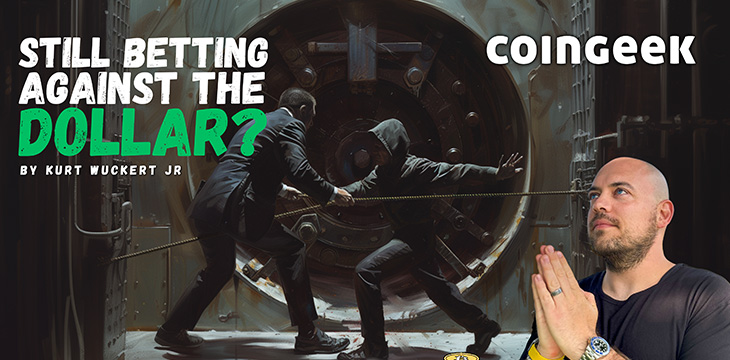|
Getting your Trinity Audio player ready...
|
I have been a libertarian activist for over twenty years. In my senior year of high school (class of 2004), I gave a presentation on the scam of central banking, how controlling the issuance of money gives insiders a headstart that nobody can surmount, and how nations are basically free-range, corporate plantations.
If you’re familiar with early Bitcoin culture, you can see why I was attracted to Bitcoin immediately when I heard about it. If you’re new here, it didn’t used to be all about “number go up,” but it was an activist project designed to disrupt global payments, remittance and banking.
I was convinced the collapse of the dollar was imminent and that a rapid de-dollarization of the world would make holders of gold or similar assets the new ruling class by de facto. But twenty years after my high school presentation on the imminent collapse of the dollar [side note: are my friends going to invite me to my high school reunion?] I have come to realize I was obviously overzealous.
Some background
I am far from the first critic of the U.S. Dollar.
On this day 190 years ago, September 10, 1833, at the end of the “Bank War,” Andrew Jackson announced that the United States would no longer use the Second Bank of the United States.
There was widespread resentment toward the bank in the aftermath of the Panic of 1819. Many… pic.twitter.com/5MCXbWYMBa
— Liam McCollum (@MLiamMcCollum) September 10, 2023
Going back to the founding of the nation and earlier, sound money advocates hated central banks, but the world never had a pure experiment in fiat maximalism until the dollar got 100% off of the gold standard with the dissolution of the Bretton Woods agreement, which was a middle-ground stepping stone used to move the world away from the gold standard over a generation. Thanks, Richard Nixon!
Today is the 50th anniversary of Nixon "temporarily" suspending the dollar's convertibility into #Gold, opening the doors for the unlimited deficit spending and money printing. Today, we draw near to the conclusion of this monetary story arc… pic.twitter.com/RaaHhAa4zD
— Egon von Greyerz (@GoldSwitzerland) August 15, 2021
In the decades following the dissolution of the Bretton Woods agreement in 1971, many financial skeptics have wagered against the dollar, convinced that its collapse was imminent. They saw the dollar’s decoupling from gold, rising national debt and expansionary monetary policies as signs of an impending crisis. Yet, time and again, these doomsayers have been proven wrong. The dollar has not only survived but thrived as the world’s most trusted and liquid currency, underpinning global trade and finance.
Yes, the purchasing power of the dollar has generally trended downward, but wealth and tons of metrics about the spreading of wealth are way up across the globe for every nation that uses the dollar in their economy, and it is up against most competing national currencies.
While criticisms of the dollar and central banking are valid, it is crucial to acknowledge that betting against the dollar has been a losing strategy for nearly half a century. Those who have clung to the belief that the dollar would collapse have missed out on generational wealth that could have been built by investing in companies in the Western Hemisphere that are tied inextricably to the dollar’s power. This wealth could have been accumulated passively by recognizing the dollar’s resilience and its central role in the global economy.
Bitcoin’s rise and the ‘Tetheral Reserve’
Fast-forwarding through a generation of foreign and monetary policy and a few boom-and-bust cycles in which the dollar has continued to come out on top, Bitcoin has often been hailed as a hedge against the collapse of the dollar by advocates, including myself, for a time.
Many in the BTC maximalist community argue that as fiat currencies falter, BTC’s value will soar, providing a safe haven for those looking to preserve their wealth. We haven’t seen this, but the meme persists because of BTC’s general price appreciation despite the fact that the performance tends to mirror risk on tech stocks rather than a trusted hedge. BTC is admittedly the greatest performing chart of all time, but the reality of the underlying mechanisms is more complex, and to date, we have seen no calculable correlations between BTC’s performance and the collapse of the dollar.
BTC’s meteoric rise has not been due to a dollar collapse but rather the result of market manipulation within the crypto bucket shop economy—a manipulation spearheaded by Tether, Inc.
Tether, the company behind the stablecoin USDT, has essentially created a parallel to the Federal Reserve within the crypto crime world. By printing Tether with a known fractional reserve (a major criticism of central banking), they have injected liquidity into the markets where they see fit, inflating prices and creating the appearance of organic demand. This “Tetheral Reserve” has allowed BTC to rise in value as part of their broader meme. But this rise is not a result of the dollar’s weakness. Instead, it is a direct reflection of a new form of central banking within the digital currency space, one that operates with far less transparency and accountability.
Critics should be reminded that Tether’s malfeasances are far more than theoretical.
Mention a Tether conspiracy that has proven to be wrong, I’ll wait.
The NYAG and CFTC both found Tether to be lying about their reserves. https://t.co/AKq9aE1XaF pic.twitter.com/EIAFrD7xOd
— Danny (@danny_mx) August 26, 2023
In 2021, Tether, Inc. and its sister company, Bitfinex, reached an $18.5 million settlement with the New York Attorney General’s (NYAG) office following an investigation that revealed the companies had misrepresented the extent of Tether’s reserves, falsely claiming that each Tether token was fully backed by dollars. The NYAG’s office found that Tether had, at times, held no reserves to back the stablecoin and that Bitfinex had used Tether reserves to cover up an $850 million loss, leading to the conviction for fraudulent accounting practices.
The fallacy of Gresham’s Law and the Lindy Effect in Bitcoin
A common belief among BTC advocates is that Gresham’s Law and the Lindy Effect will inevitably drive value toward BTC. Gresham’s Law, which states that “bad money drives out good,” is often interpreted by Bitcoiners to mean that people will eventually reject fiat currency in favor of Bitcoin, the “good money.” The Lindy Effect, which suggests that the longer something has existed, the longer it is likely to continue to exist, is similarly invoked to argue that Bitcoin’s staying power will grow as it continues to survive.
These quotes can be found parroted by the influencer de jure of every bull cycle, and I won’t be linking to examples for both my own sanity and yours.
Why?
Their line of thinking is fundamentally flawed. If Gresham’s Law and the Lindy Effect are indeed in play, they are far more likely to reinforce the dominance of the dollar in times of crisis. In a global financial meltdown, the liquidity and trustworthiness of the dollar make it the most likely refuge for capital. Following that, in a situation of rapid de-dollarization, the Lindy Effect would drive value toward gold, an asset that has served as a store of value since prehistory. Gold’s longevity and intrinsic value far surpass those of Bitcoin, making it the true “good money” in a crisis.
Plus, you have to think about how many people can even conceivably use BTC for anything today. If there were suddenly a few billion people without a reliable currency to use for global trade, the BTC network could not deal with the demand, and even if it could, most BTC is held by a very small number of people, so it has a recognizability and distribution problem—a problem that gold, silver and other precious metals do not have.
The reality of BTC as a hedge
BTC maximalists often argue that BTC is a hedge against the devaluation of the dollar, so maybe it wouldn’t be useful in a crisis, but it would at least make holders rich!
However, for Bitcoin to serve as an effective hedge, it would need to replace the dollar as a frictionless cash system capable of facilitating global trade. I still think distribution and demand for BTC is far too small for anyone to care about it under pressure. Without any useful utility, people will be focusing on basic needs, and BTC’s value proposition (of “Hodl, bro!”) remains speculative at best. The idea that Bitcoin can act purely as a “store of value” in a financial crisis overlooks the fact that in such times, the market will gravitate toward assets with proven stability and historical significance—namely, gold.
While BTC has proven itself as a fantastic speculative asset, it has not yet demonstrated the ability to function as a global currency or a tool for anything useful to average people. As long as it remains tethered to speculative forces and lacks widespread adoption for everyday transactions, its role as a hedge against the dollar will remain tenuous.
The challenges of central banking and the path forward
It is important to acknowledge the numerous flaws inherent in central banking and the central planning of economies. My criticisms of these things have not changed because the concentration of monetary power in the hands of a few is fundamentally immoral, in my opinion, and in practical terms, it has led to a range of economic distortions and inequalities.
Bitcoin is only a hedge against these issues if it can truly function as a replacement for the dollar or as a rail for it to reduce USD friction and increase its auditability so it can become a currency that can facilitate global trade efficiently and transparently. For this, Bitcoin must have robust and scalable infrastructure for tokenization, something really only being worked on in the BSV contingent on the broader Bitcoin landscape.
In the end, while we should remain critical of central banking practices, it is crucial to recognize the enduring power of the dollar and the limitations of Bitcoin as it currently stands. The path to disruption lies not in betting against the dollar or clinging to the speculative value of Bitcoin, but in building a truly distributed, truly scalable financial system that can operate alongside or even replace existing structures—one that, so far, can only potentially be realized with BSV.
This, not BTC’s speculative bubble, is where the future of finance may truly lie.
But until all of that comes to a head, it might continue to be wise to hold all variant bitcoin assets in a conservative portfolio while the engineers and the market figure out the ways to truly fix the money.
Watch: Determining blockchain’s economic value

 01-10-2026
01-10-2026 




